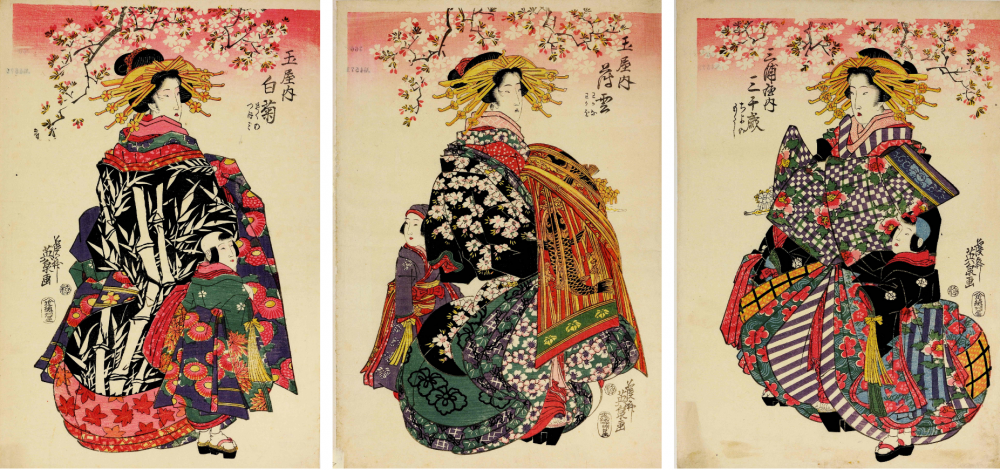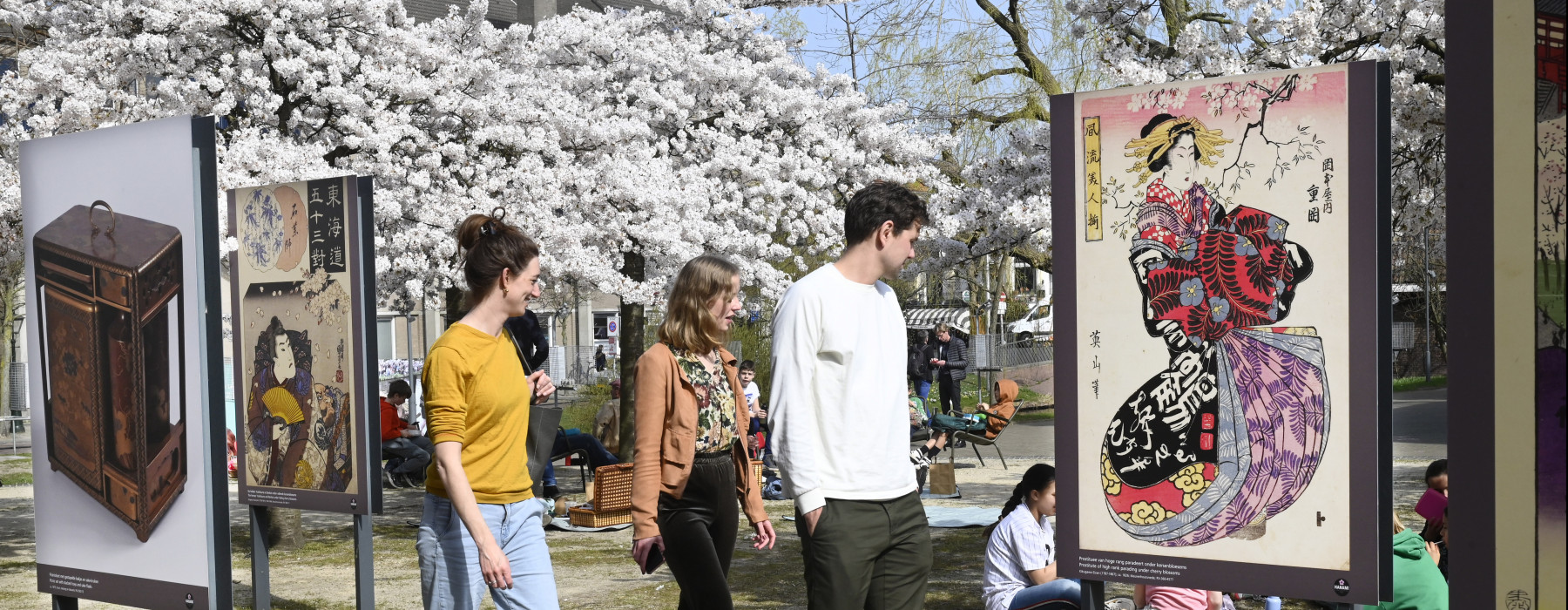
Read more about what you can see below. Keep this webpage open on your mobile for the background information, while you can admire the large images on location!

Starting on February 2, you’ll find a temporary outdoor exhibition near the cherry trees with photos of objects from the collection. At the museum café, there will be even more large pictures on display. The outdoor and café exhibitions can be visited free of charge. Some of the original objects featured in the posters are on display in the Japan & Korea gallery.
Read more about what you can see below. Keep this webpage open on your mobile for the background information, while you can admire the large images on location!
Going for a picnic on Asuka Hill
The park on Asuka Hill in Edo (present-day Tokyo) was laid out in 1720. Tokugawa Yoshimune, the shōgun or military leader of Japan, had 1270 wild cherry trees planted there. Before long, local citizens were allowed inside to enjoy the park. And it quickly became a hanami hotspot for picnics with beautiful views.
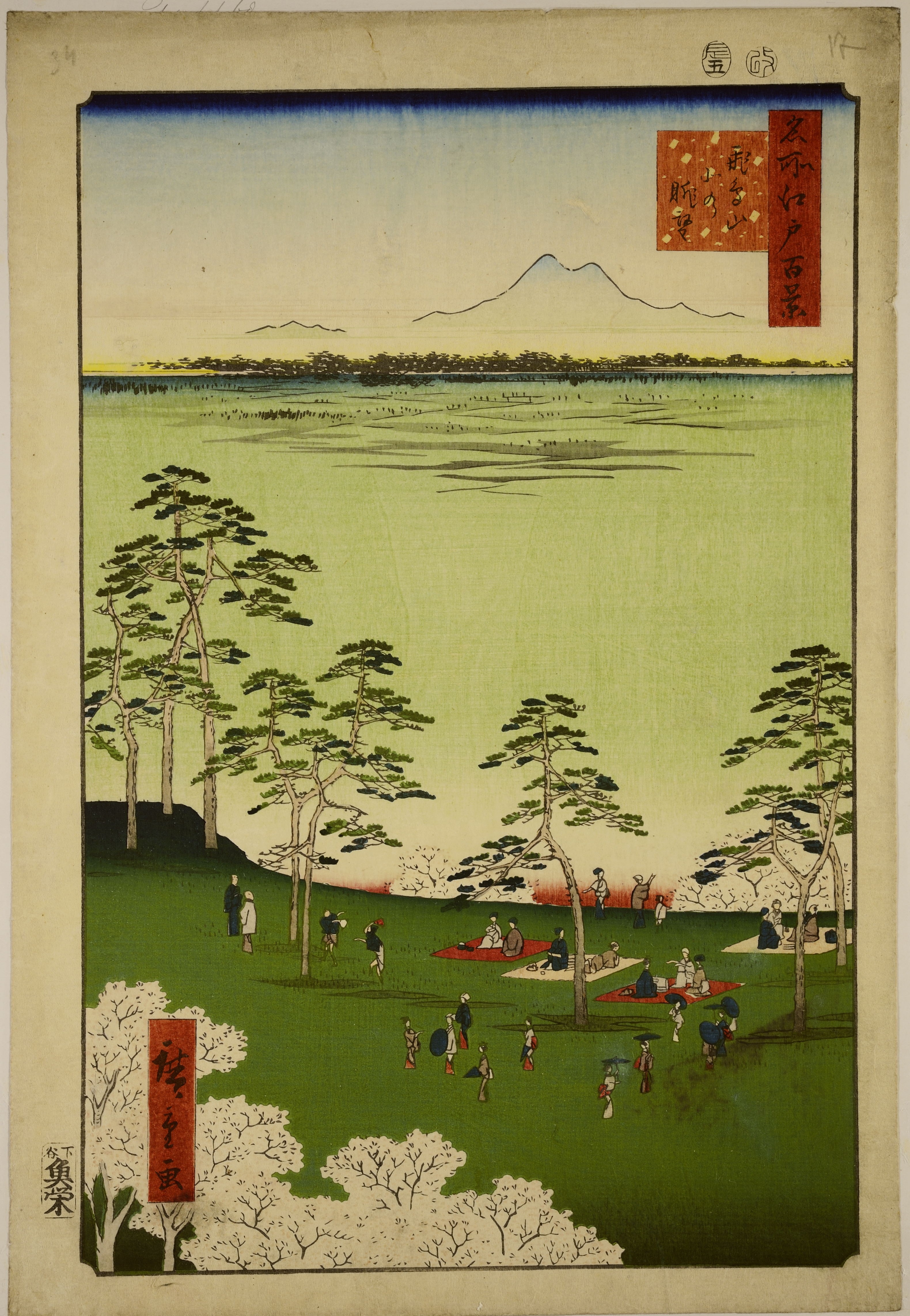
Meeting and dancing under the cherry blossoms
The upper painting shows two potential marriage partners meeting for the first time. The young man is sitting next to the marriage broker under the blossoming cherry tree, while the proposed bride and her entourage approach from the left.
In the lower painting, hanami is in full swing: with a geisha playing music on the left, and in the middle a man performing a fan dance to the music.
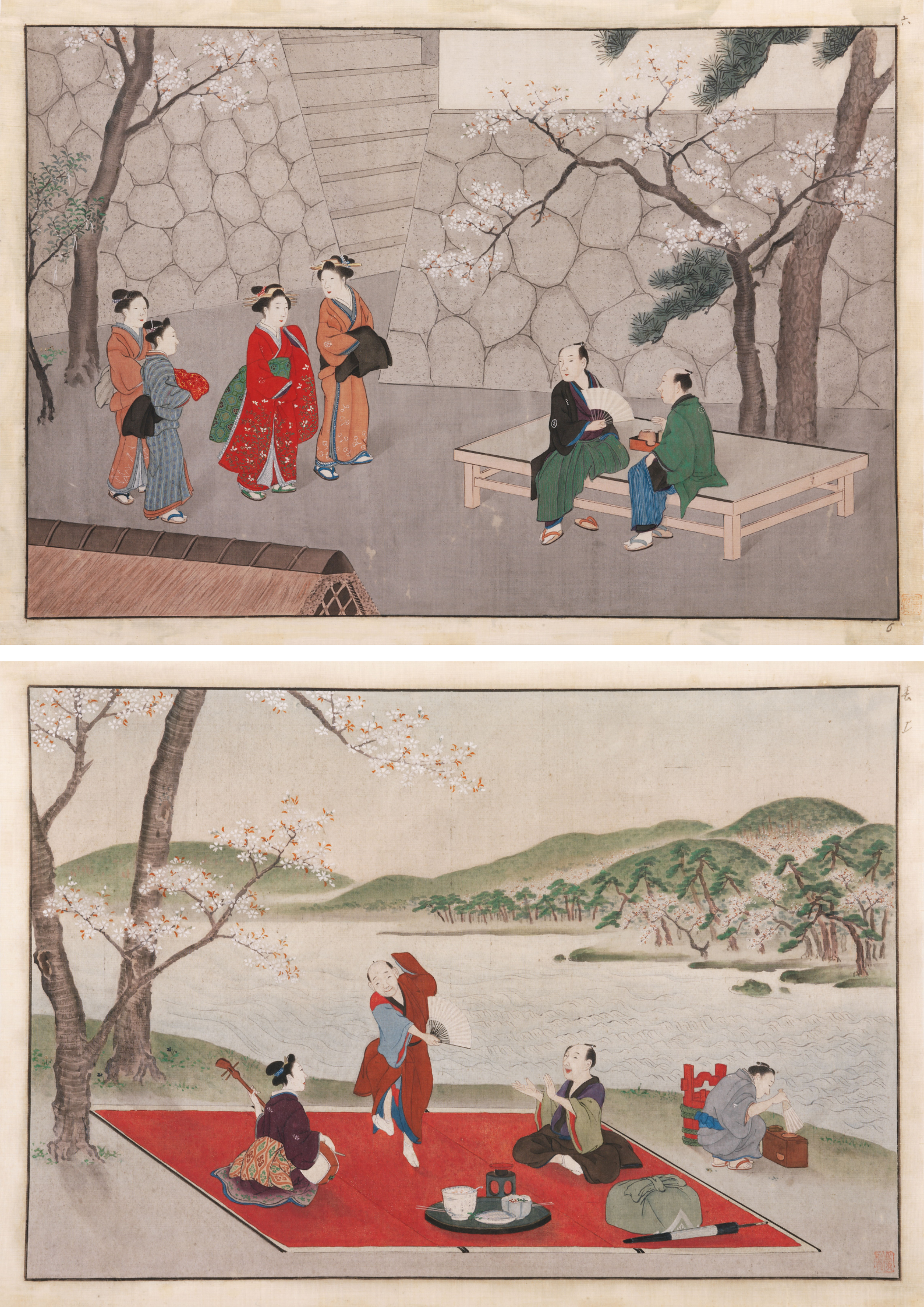
The warlord Taira no Tadanori
Tadanori (?-1184) was not only a skilled military leader but also an avid poet. His best-known poem is about sleeping under a cherry tree, while its blossoms watch over him like an innkeeper. Tadanori died in battle and the enemy recognised him by the poem he carried on his body.
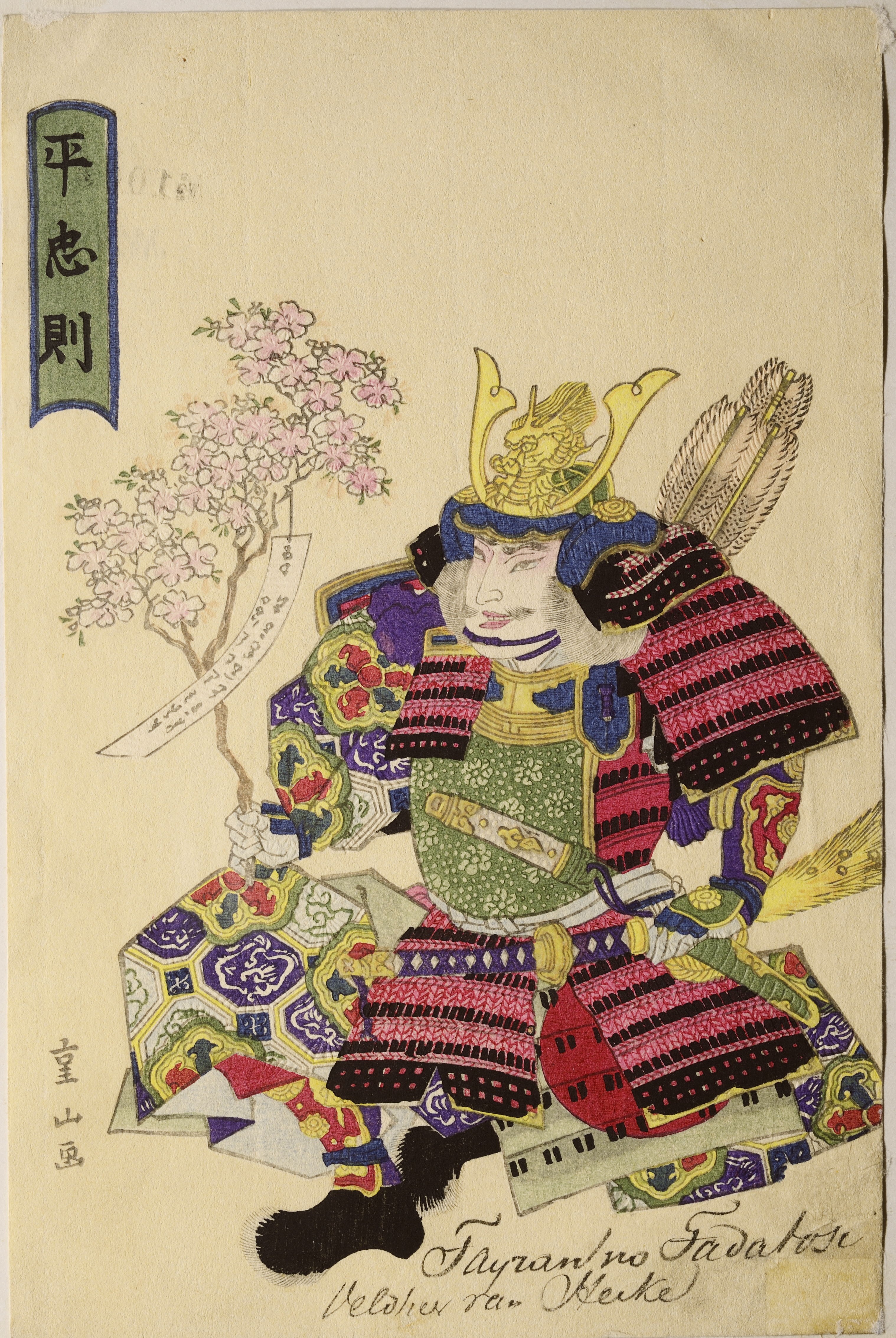
Portable stacked trays with plum blossoms
This luxury lacquerware set is decorated with plum blossoms. Plum trees bloom earlier than cherry trees, just after the snow has melted. The two can be distinguished by the shape of their petals. Cherry blossoms have a split at each petal tip. Plum blossom petals have rounded tips, as on this object.
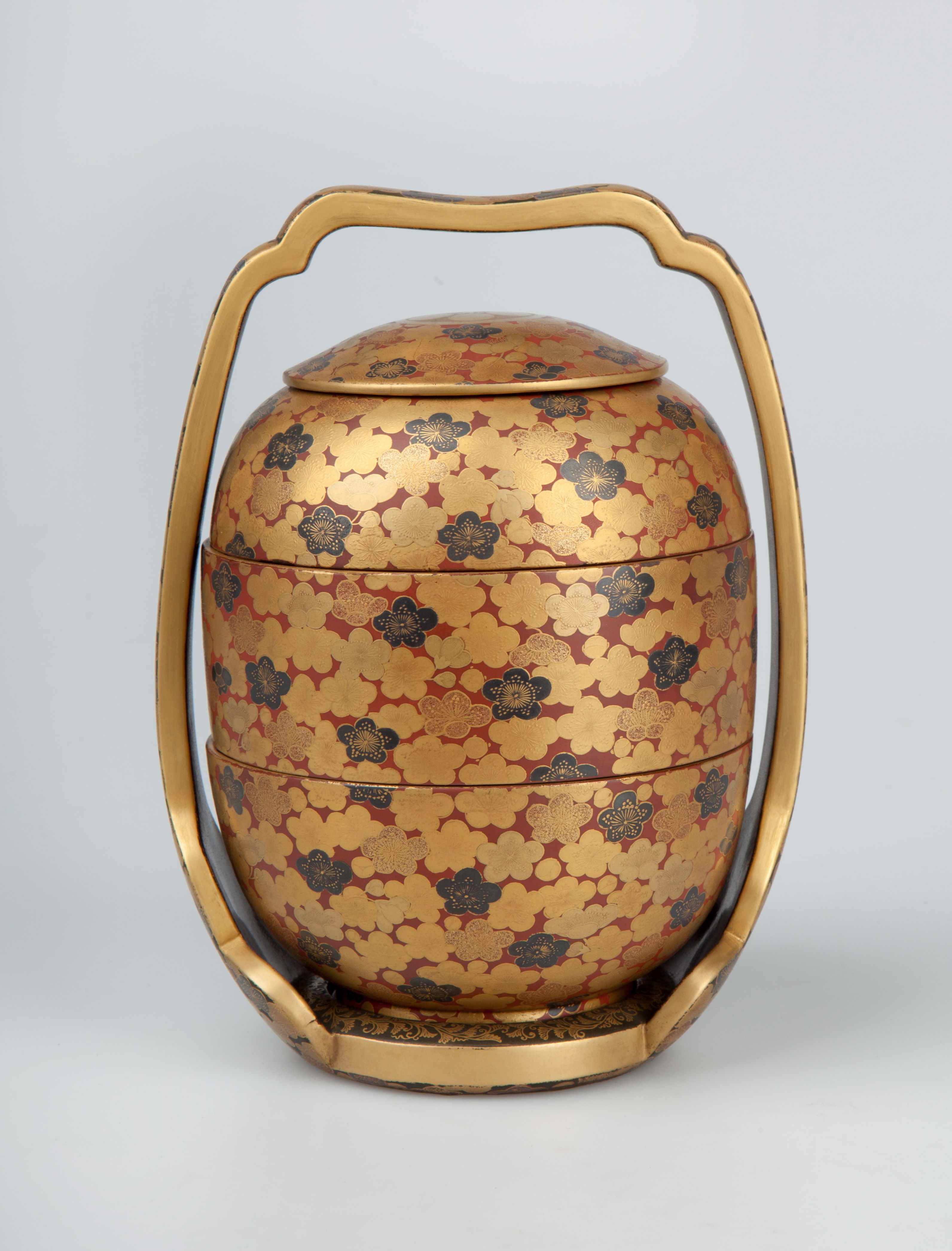
On the way to hanami picnic
This party has come prepared, with nice clothes, packages with food and drink, and a rolled-up mat to sit on. The painter Hokusai, who was already famous at the time, created an entire series on Japanese life, in a style that seems almost European. The paper he used came from Zaandam in the Netherlands and had been imported by Dutchmen.
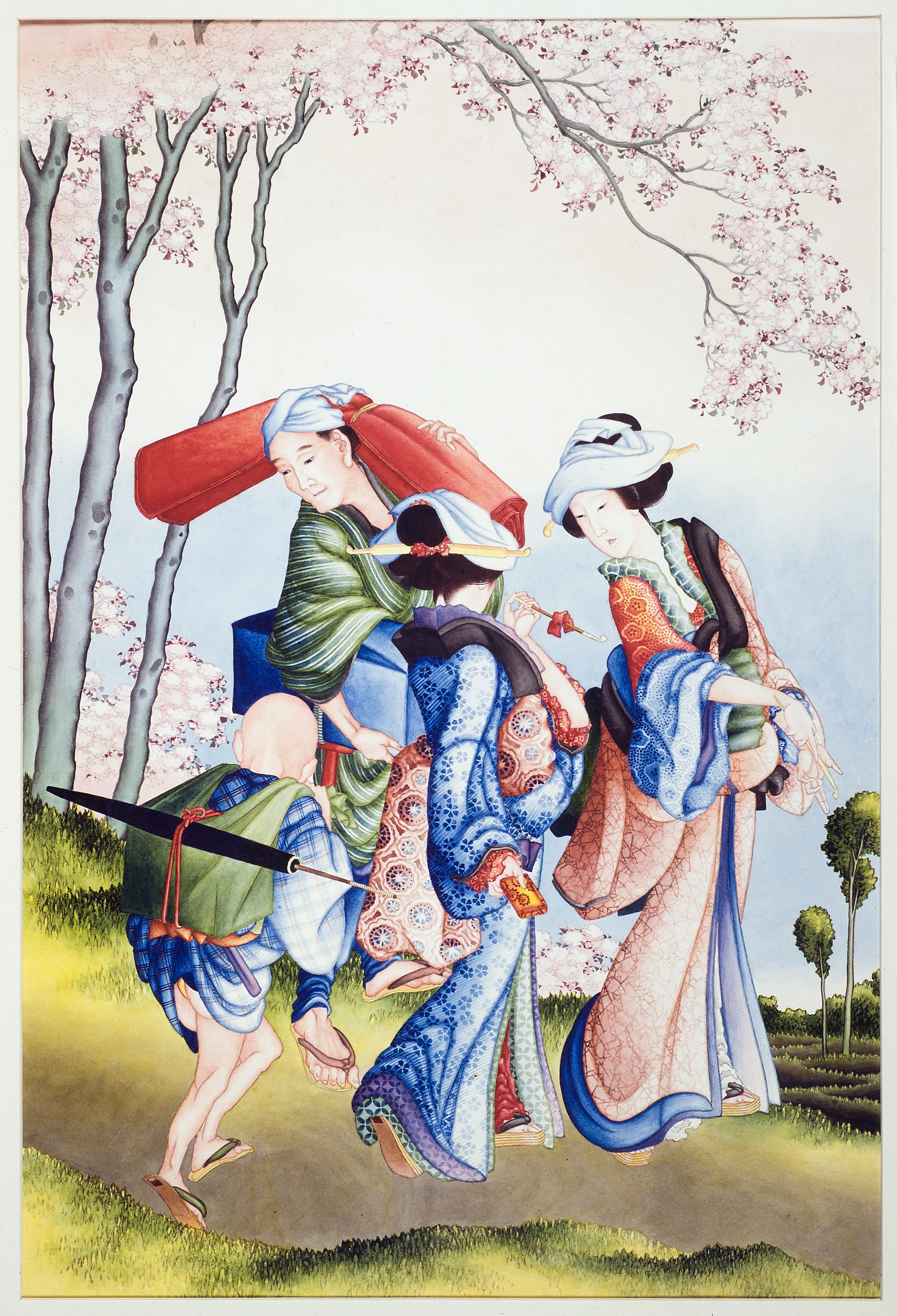
Sake kettle
This is a kettle for pouring sake, an alcoholic drink made from fermented rice. The weather can still be quite cold during hanami, so it is nice to drink sake warm. Alcohol has always played a part in the exuberant celebration of cherry blossoms.
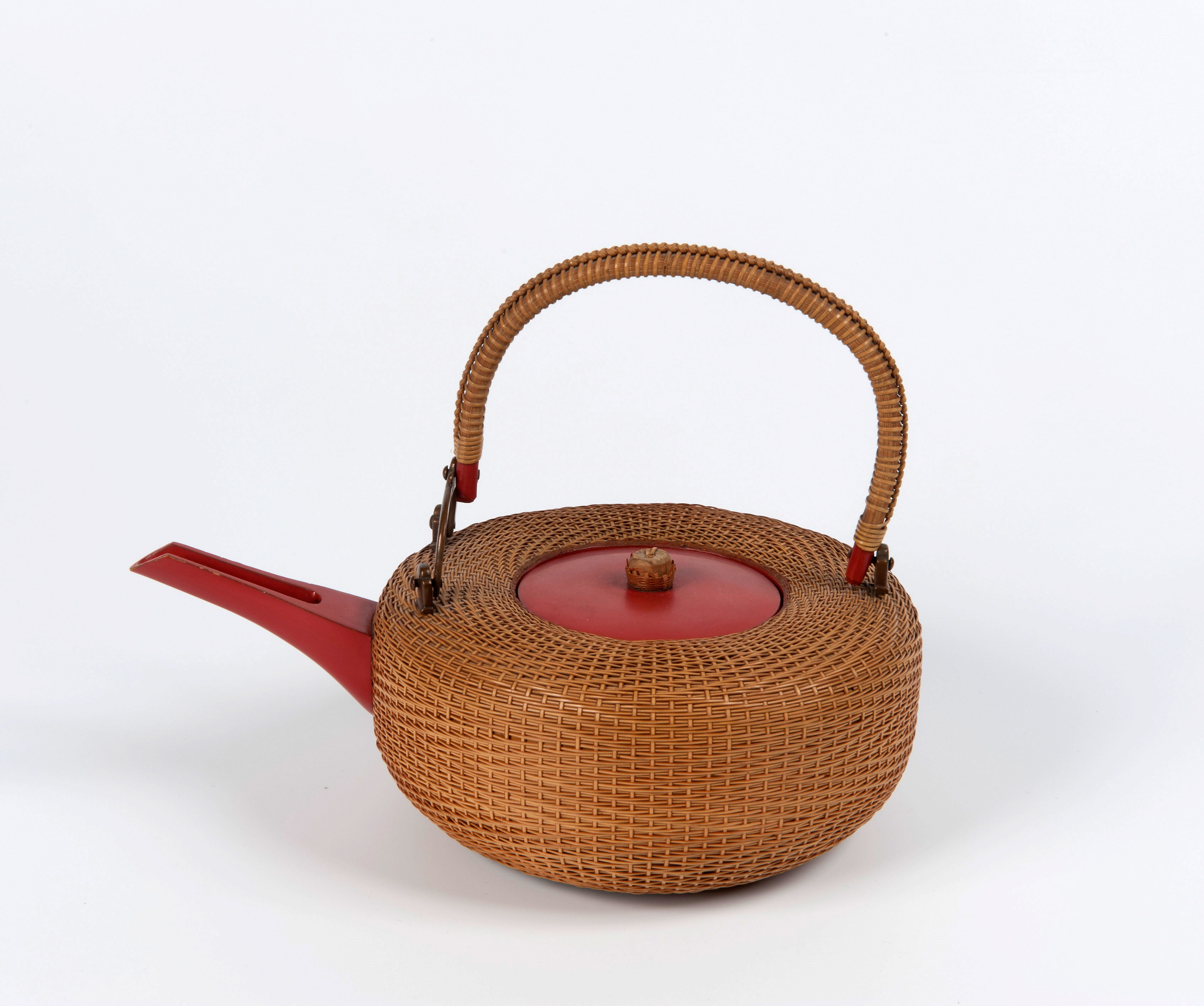
Cherry blossoms (top) and plum blossoms (bottom)
Plum trees are the first to bloom in the new year. In China, plum blossoms have been popular for millennia while in Japan, cherry blossoms are preferred. The easiest way to tell them apart is by checking the petals: cherry blossom petals have split tips; plum blossom petals have rounded tips and are evenly shaped.
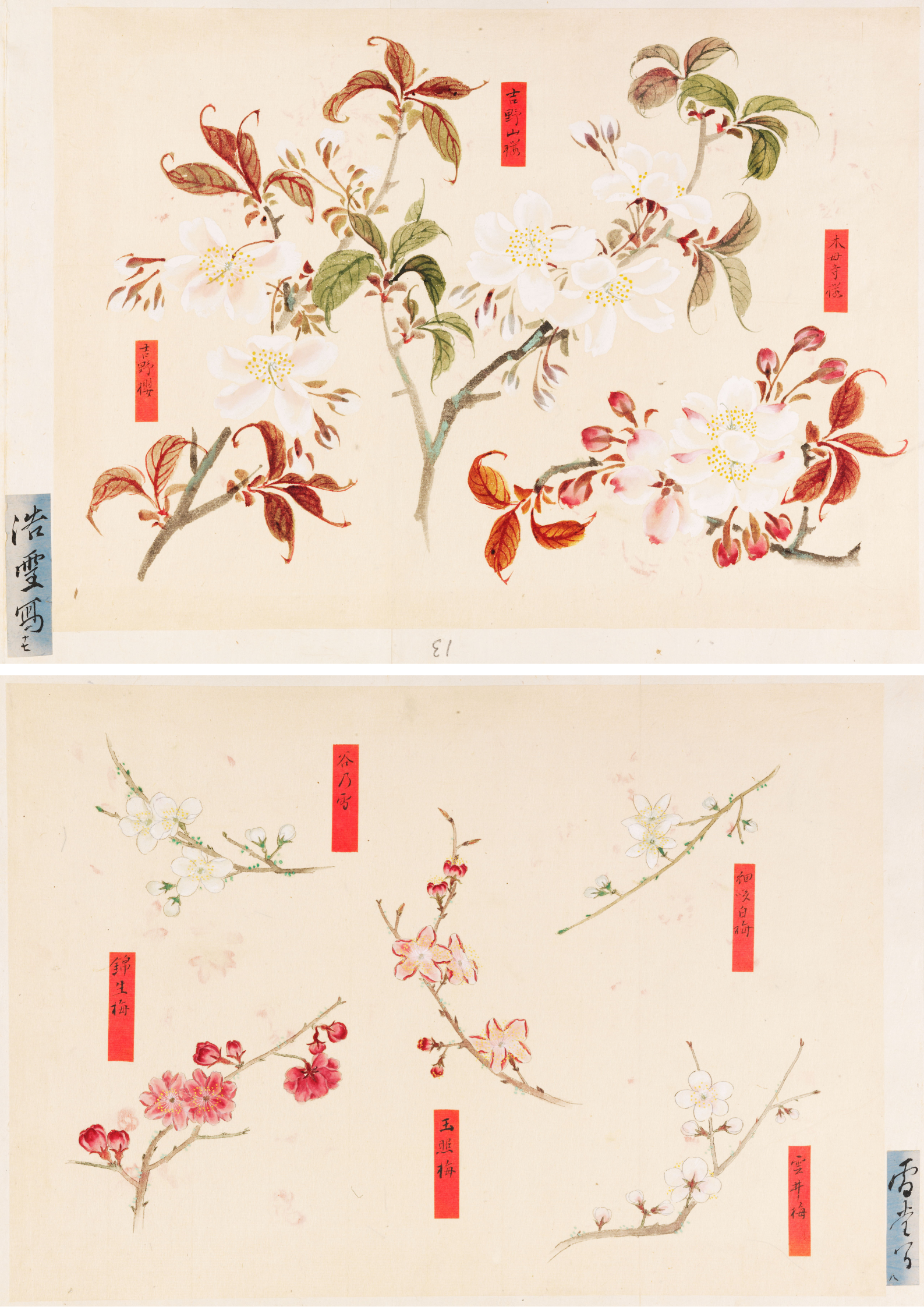
Actor in female role under nightly blossoms
In kabuki theatre, still popular today, all roles are played by men. An actor playing a female role can be identified by the small purple headcloth covering his shaved forelock. Here, Segawa Kikunojō III plays the spirit of the cherry tree. The gradient on the bottom is suggestive of a ghost, emerging from the evening mist.
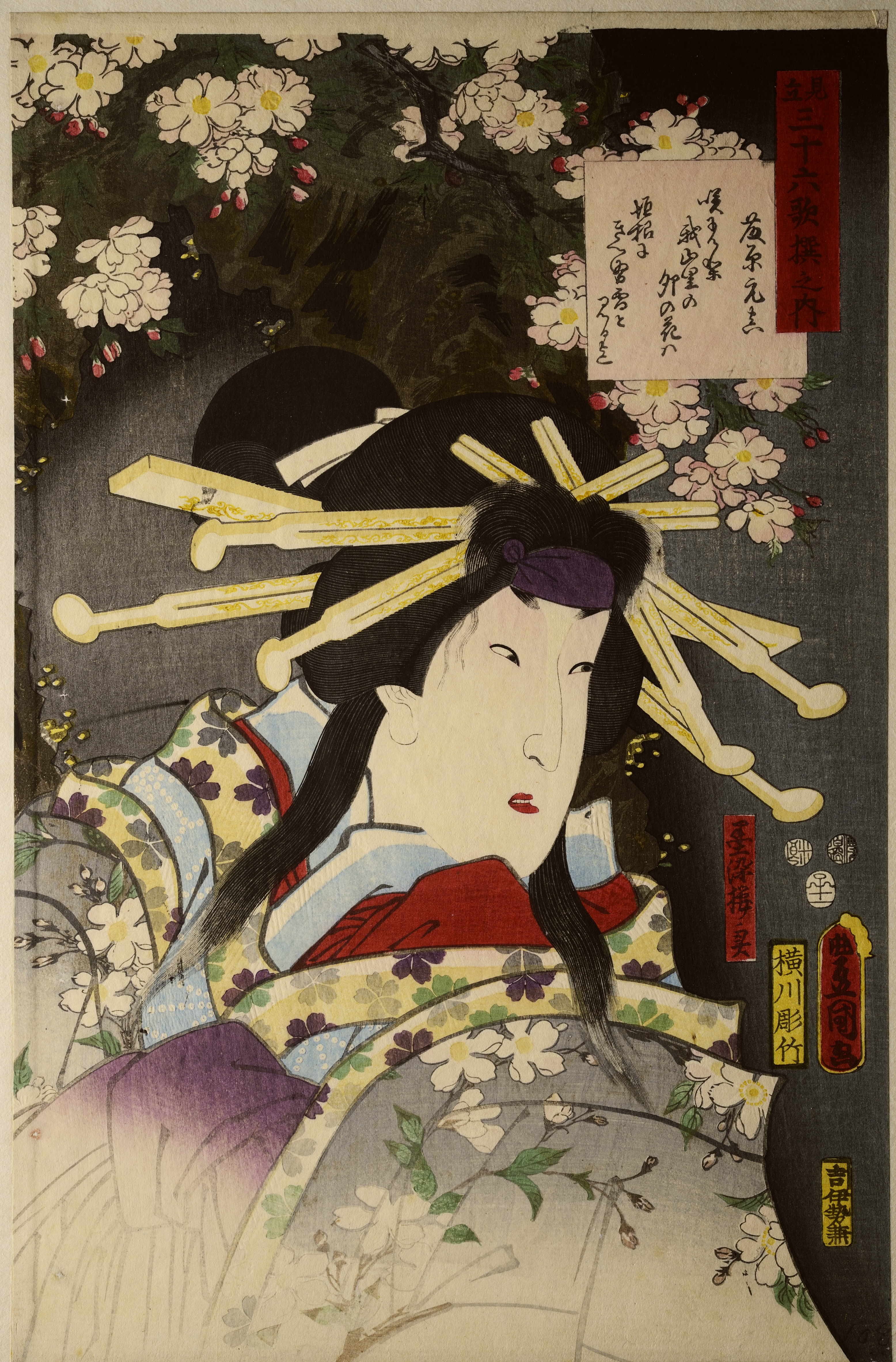
Blossoming cherry trees at Hasedera Temple
A bird’s-eye view of the Hasedera Buddhist Temple, with lots of people about. The covered steps to the main building pass through a sea of cherry blossoms. A breathtaking climb, both in terms of its beauty and the number of steps. The impermanence of the delicate blossoms has a strong symbolical connection with aspects of Buddhism.
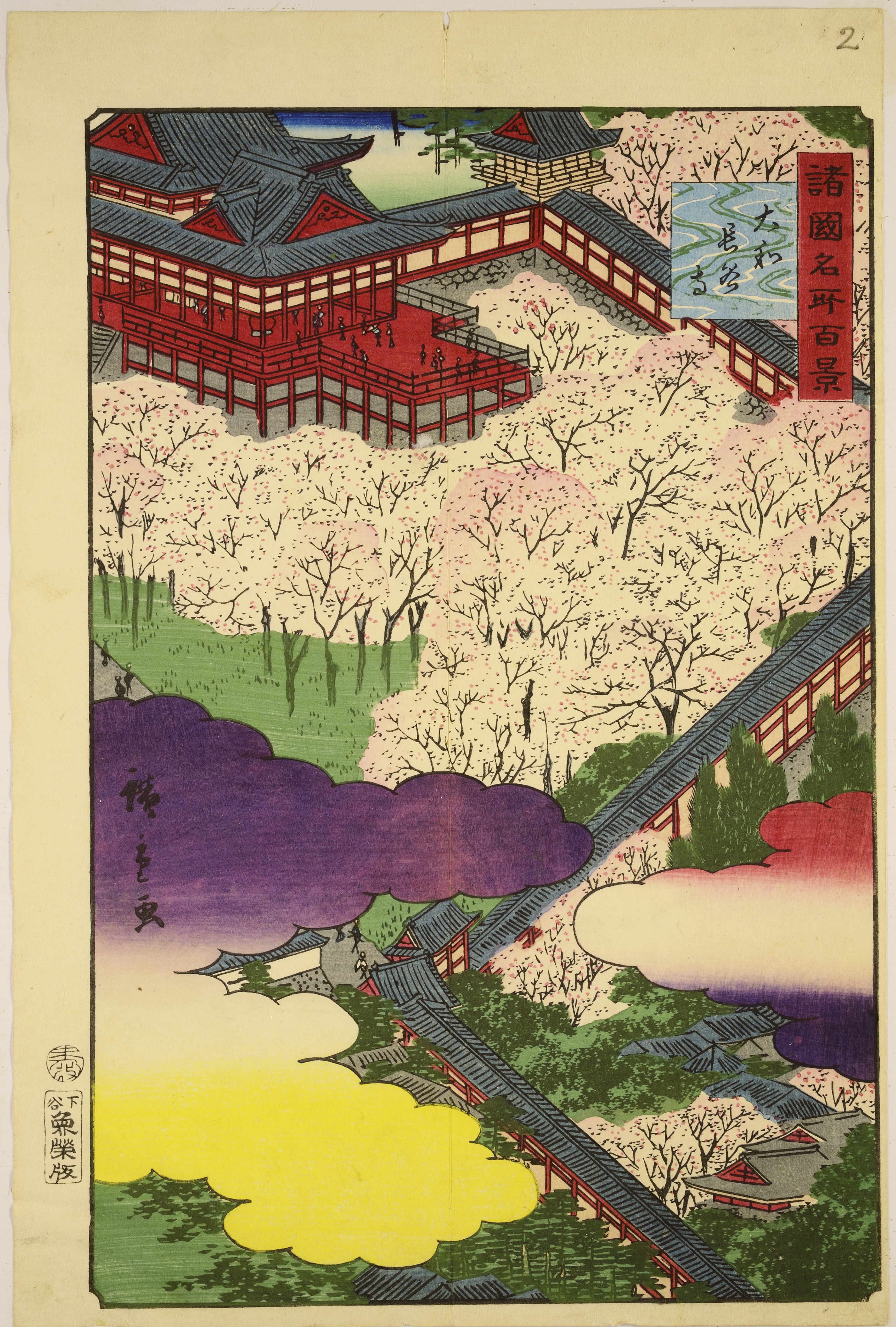
High-ranking prostitute parading under cherry blossoms
This is Shigeoka from the house of Okamotoya. She is featured here in the series ‘Beauties in the latest style’. Young women who lived in or around the official brothel district were known as the ‘Flowers of Edo’ (present-day Tokyo). But neither her many-layered silk kimono nor her many hair ornaments can disguise the fact that hers was a hard existence.
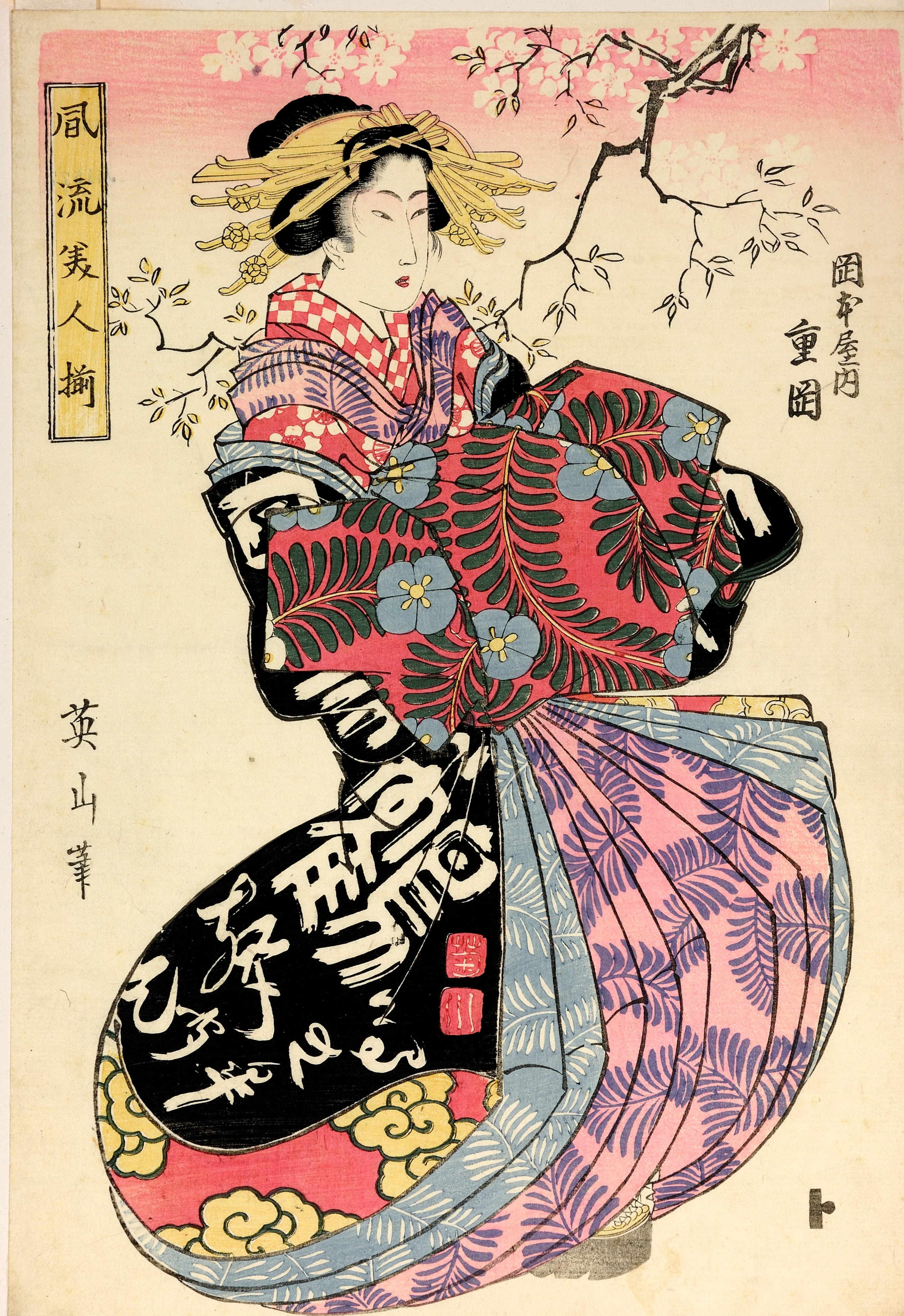
Picnic set with stacked trays and sake jars
Many centuries ago, hanami started as an outing for the elite. But gradually, local townspeople adopted the custom. Even so, this luxurious lacquerware set will have belonged to a wealthy family. Its richly decorated stacked trays filled with delicious snacks and matching jars with fine sake made this a desirable accessory.
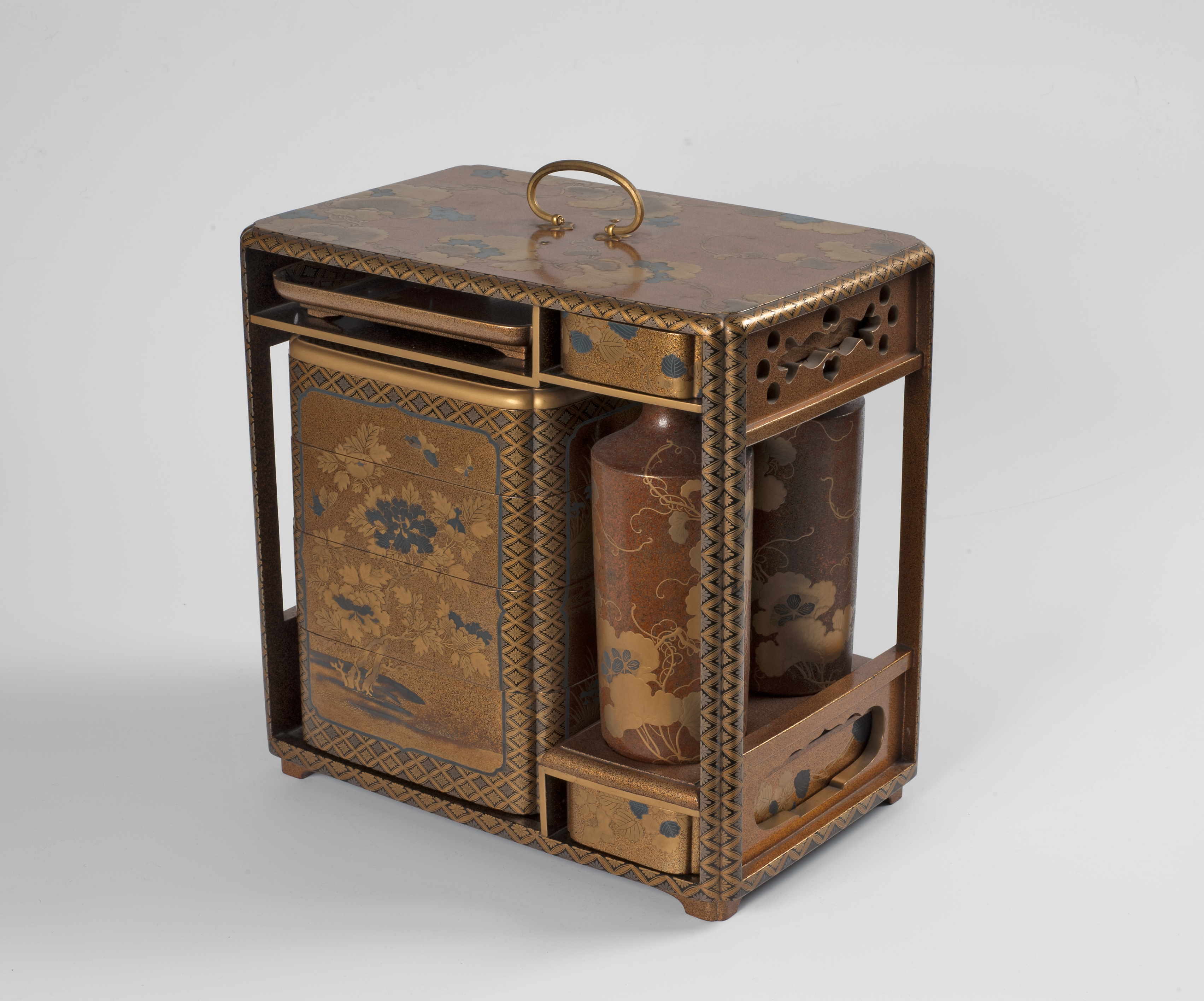
The heroes Yoshitsune and Benkei under falling cherry blossoms
Yoshitsune and Benkei are among the most famous warriors in Japanese history. They died in the wars of the twelfth century. Falling cherry blossoms often symbolise young warriors who died in battle. The cherry tree is said to have been the work of Yoshitsune’s brother Noriyori. Before the battle, he went to pray at a temple and stuck the cherry branch he was using for a horsewhip top-down into the ground. The ‘upside-down cherry tree’, sakasa sakura, was the result.
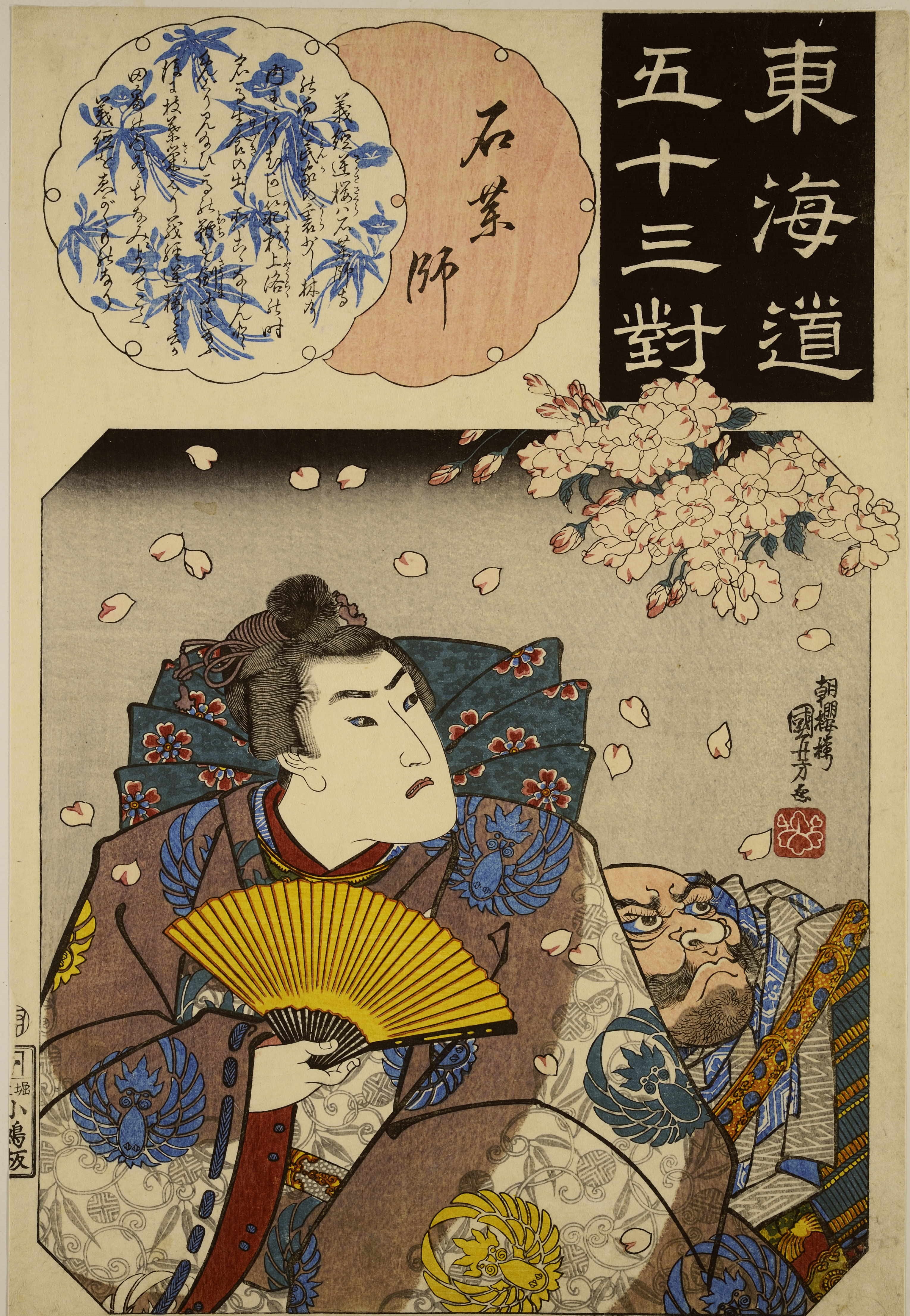
The Miidera Temple at Lake Biwa
Hiroshige drew this bird’s-eye view of Lake Biwa, not far from Kyoto. Cherry trees bloom near the Miidera Temple; parts of the roof are visible on the left. Hiroshige often placed large objects at the front of his compositions to create a stronger sense of depth.
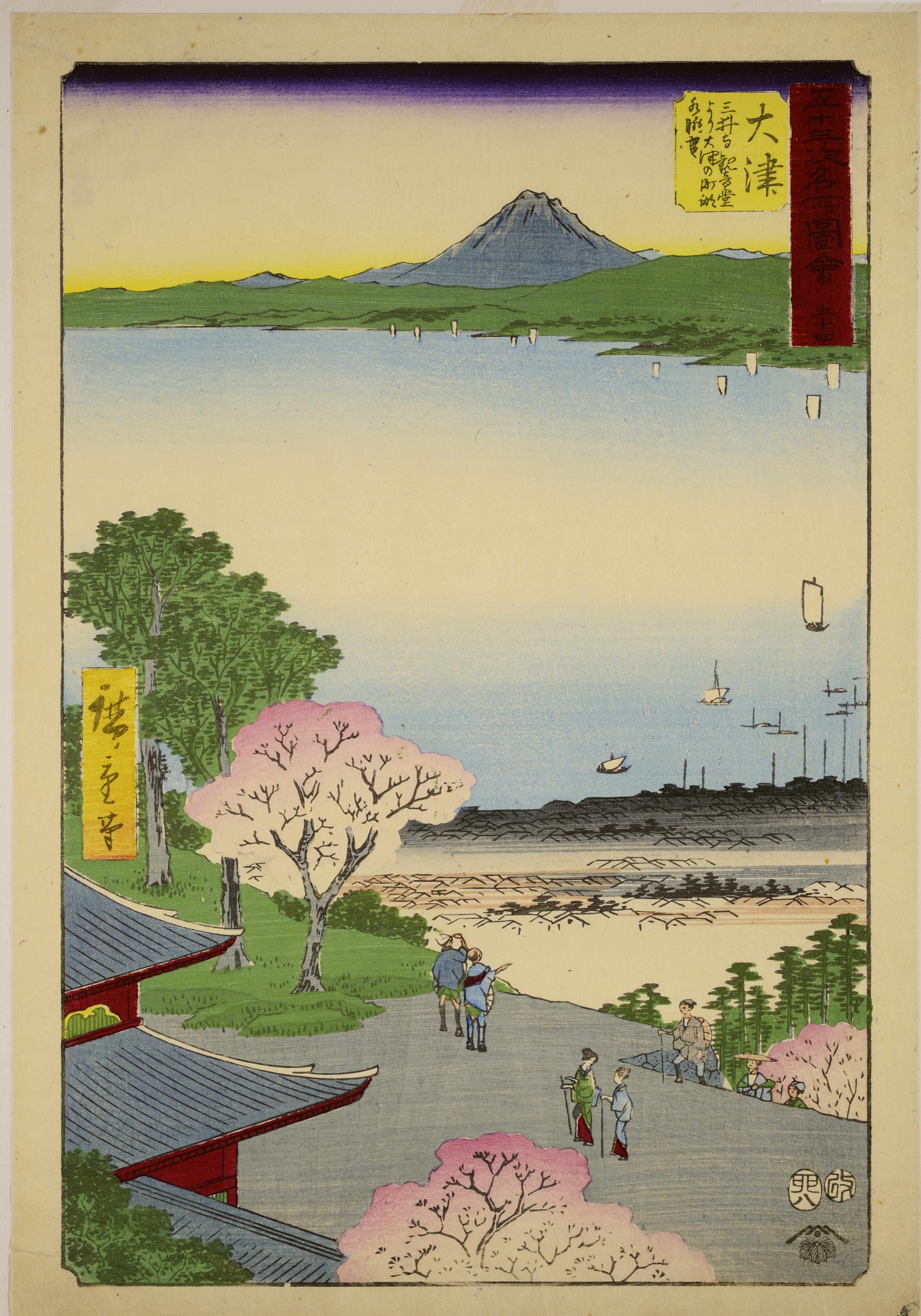
The Togetsu bridge at Arashiyama
On the northwest side of Kyoto, the former imperial capital, lies Arashiyama, the ‘Storm Mountain’. In the spring, wild cherry trees bloom on its slopes. The long, flat ‘Moon-Crossing Bridge’ has been in more or less the same place since the 9th century. With its wooden panelling over the now concrete frame, it still closely resembles the original bridge.
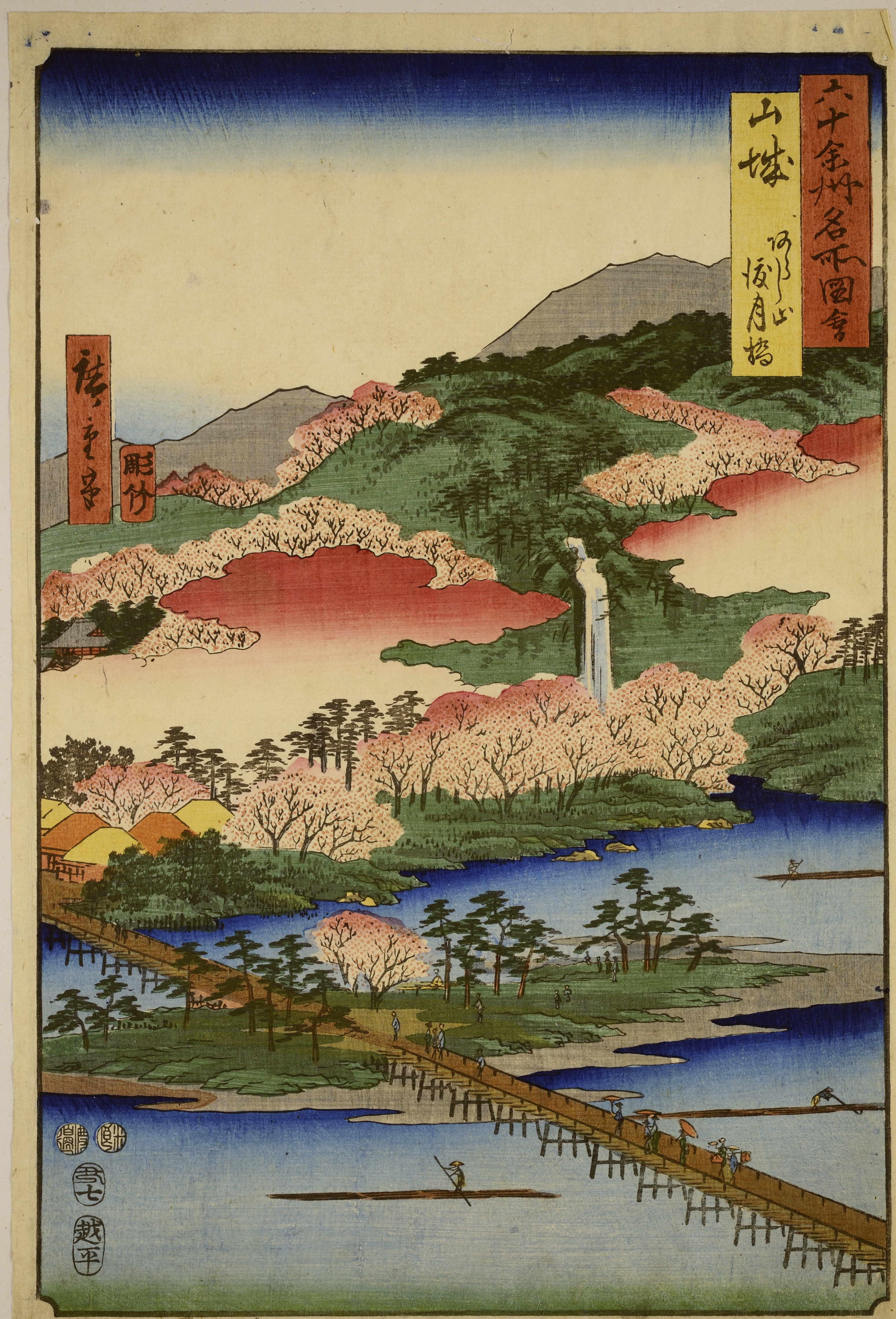
Botanical drawings of cherry blossoms
Kawahara Keiga was the officially appointed painter for the residents of the Dutch trading post of Deshima. Physician and botanist Philipp von Siebold was his best client. Keiga filled album after album with his drawings of plants and flowers, and of the fish and other animals around. His precise style shows the double rows of petals in these blossoms in great detail.
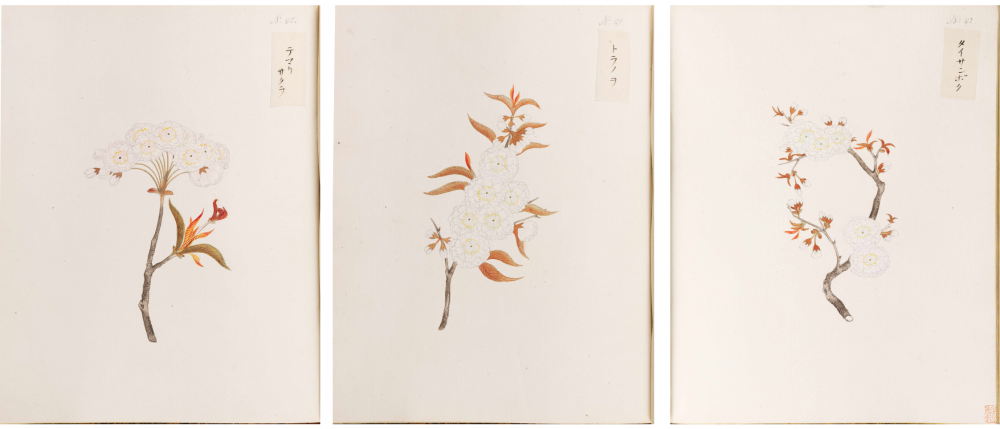
Blossoming wild cherry
Unlike in the cherry trees found in towns and parks, the blossoms of the wild cherry tree appear at the same time as its reddish leaves. Until 150 years ago, wild cherry trees were often chopped down for their wood. The trunk grows evenly in summer and winter, giving it the ideal structure for printing blocks.
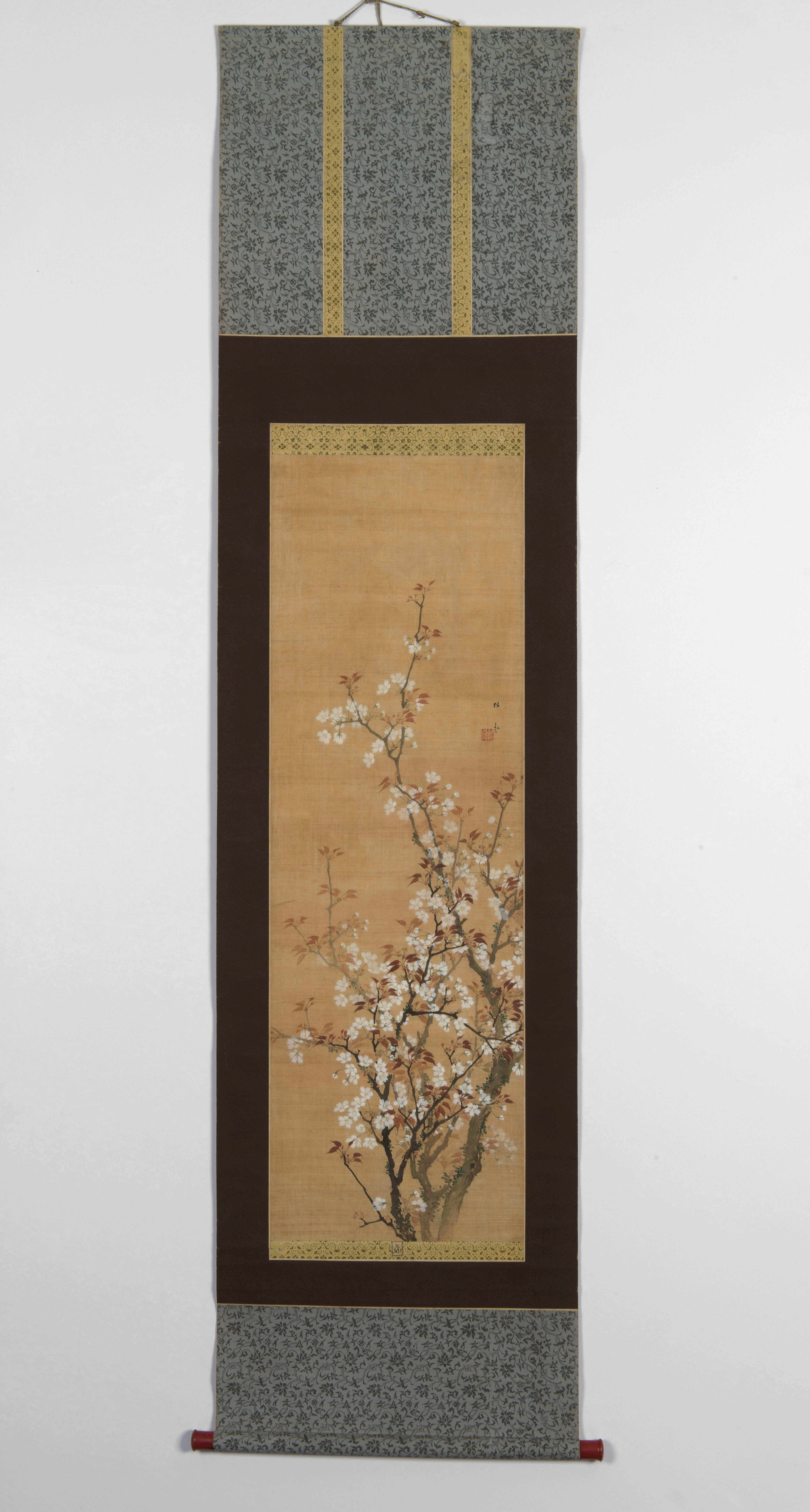
Tea outside at the shrine
An old saying has it that cherry blossoms are a sign from the gods that farmers can start planting their rice. This connects the flowers to Shintoism, the Japanese religion. In this print, large gates or torii mark the entrance to the shintō shrine. Just outside the gate is a stall with covered tatami benches.
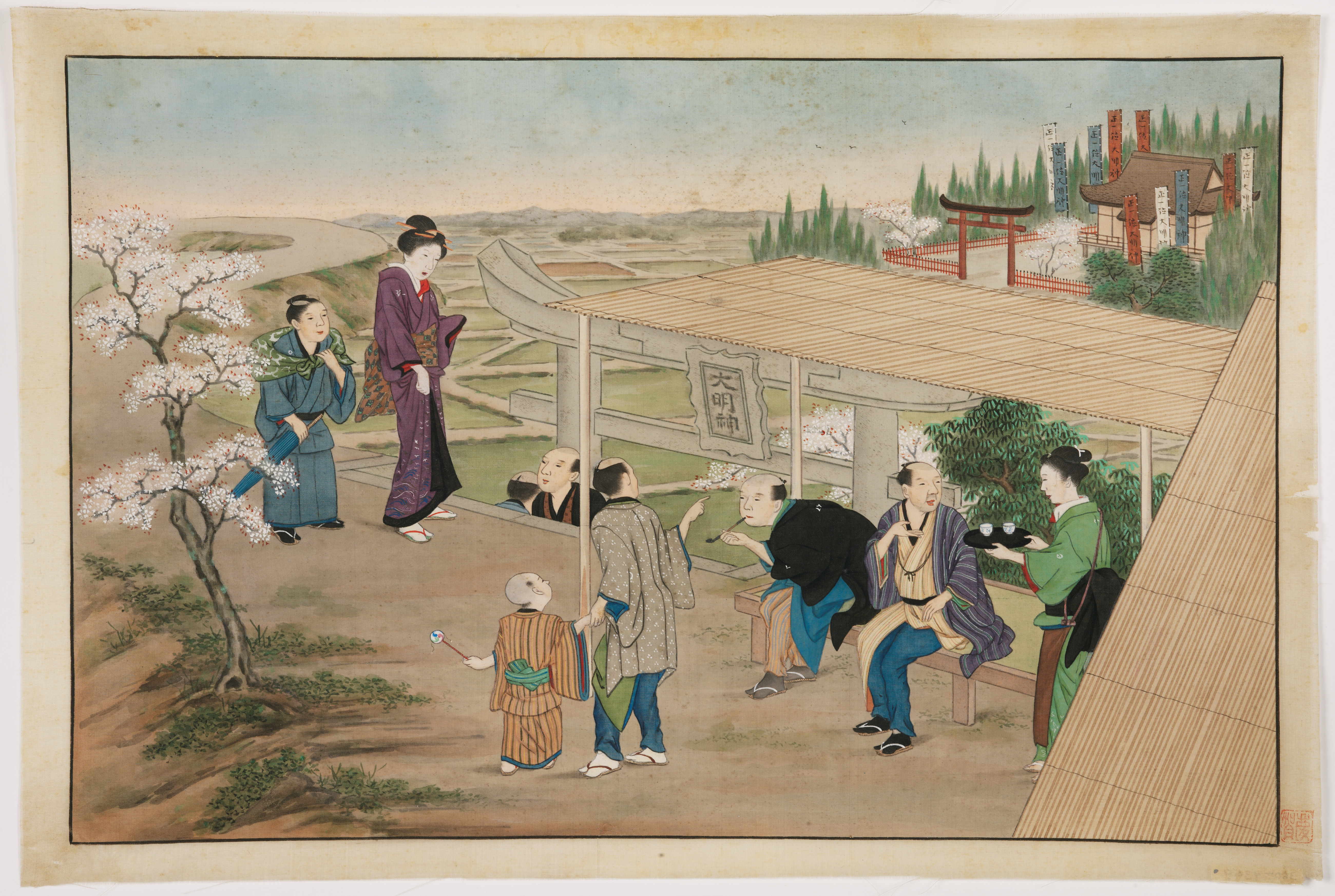
Strolling through a park with blossoming cherry trees
There are many parks in Japan with rows upon rows of cherry trees. The large Ueno Park in Tokyo is one of them. When enjoying hanami, or ‘cherry-blossom viewing’, one feels immersed in pale pink clouds. In this photo, from about a century ago, the blossoms are at their peak, or just past it: some petals can be seen on the ground.
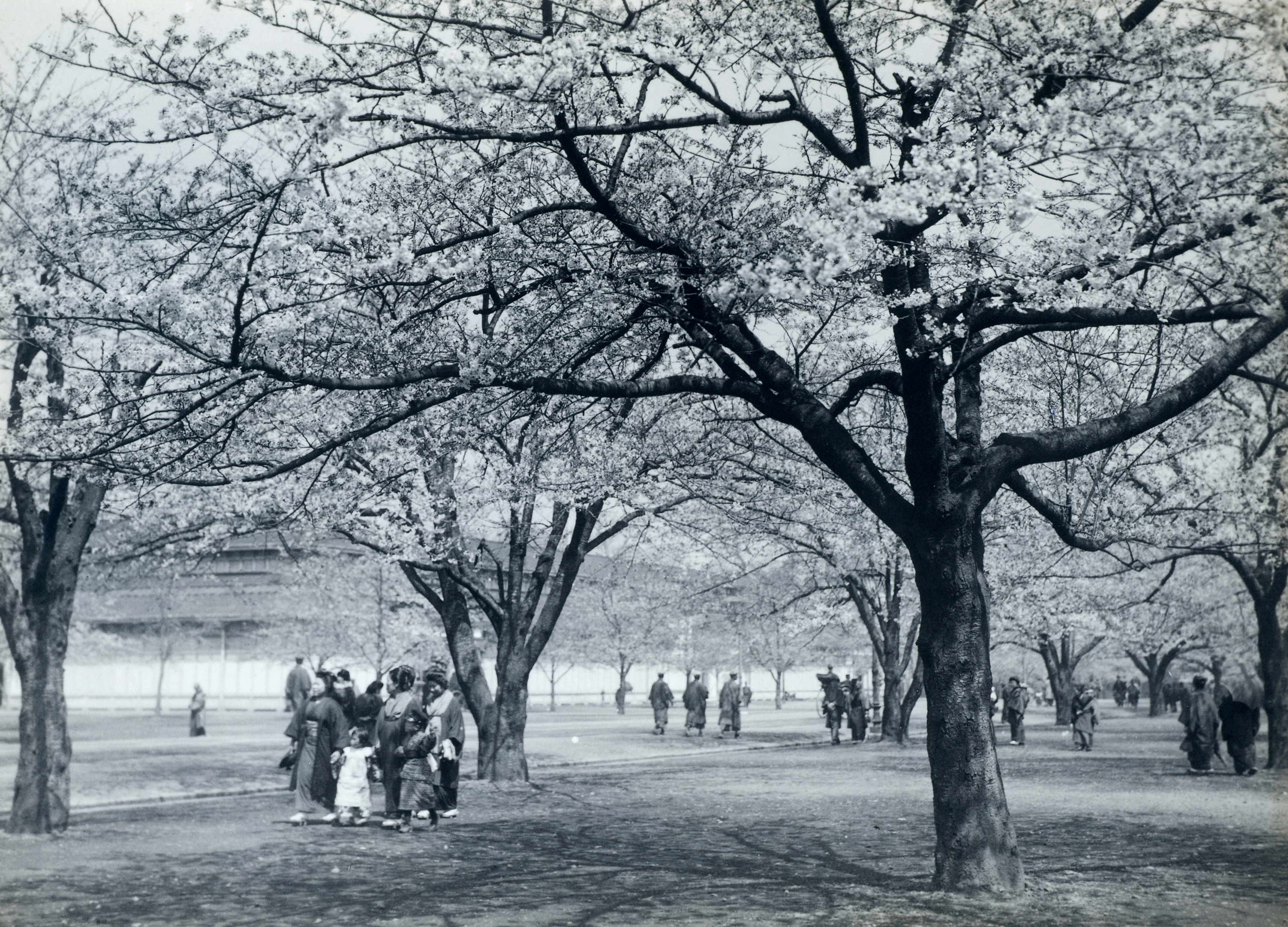
Cherry-blossom viewing on Asuka Hill
A group of women, possibly geisha, has come to the park on Asuka Hill in Edo (present-day Tokyo). The country’s military leader, shōgun Tokugawa Yoshimune, enjoyed organising falcon hunts at the park. In 1720, he had 1270 wild cherry trees planted. A little later, the local population was also allowed inside. The stone on the left commemorates the shōgun’s generosity and is still there today.
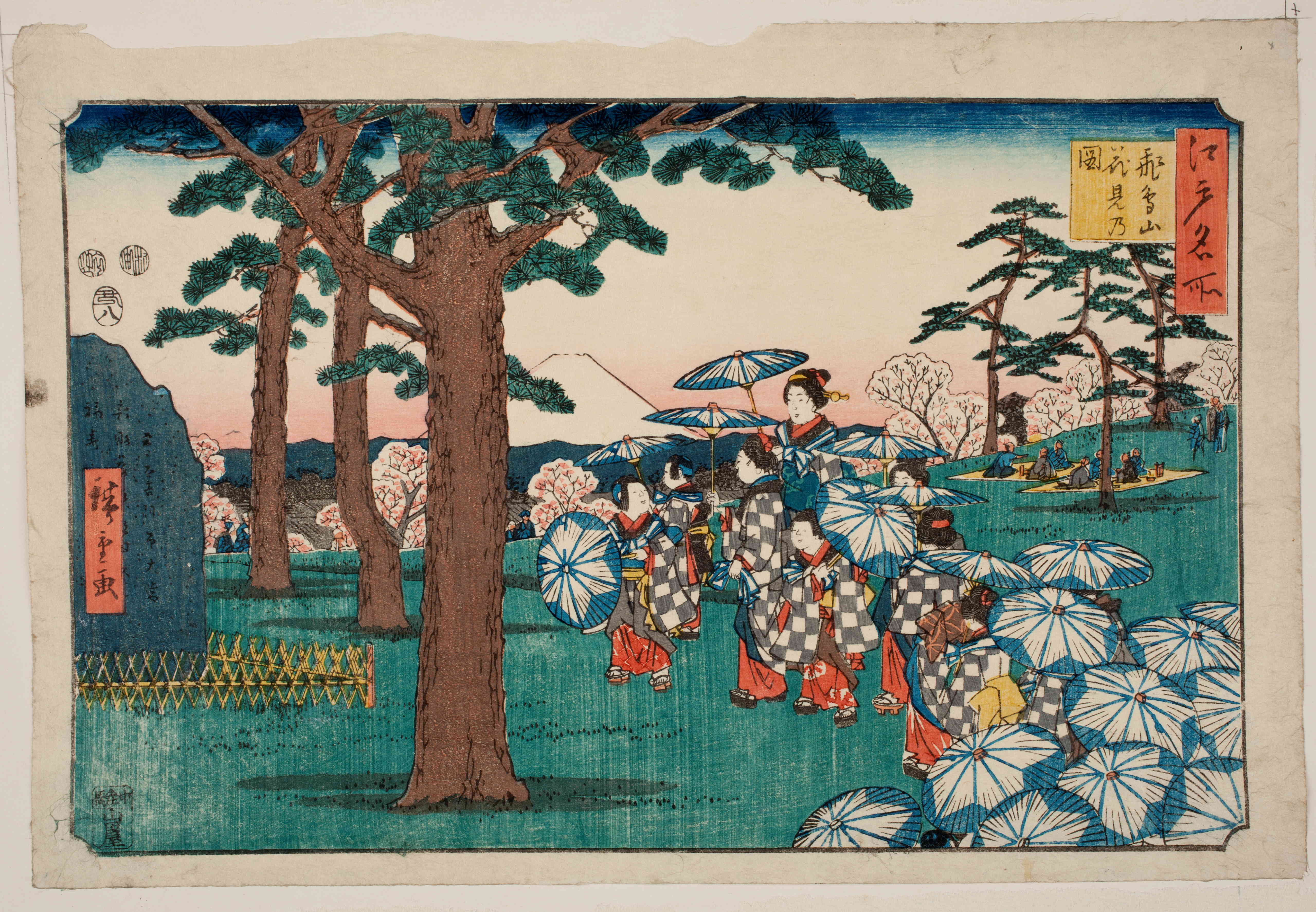
Birds around an old cherry tree in full bloom
Combining trees or plants with seasonal birds is a distinct genre in Japanese art. On the left, a blue-and-white flycatcher is flying in. This migratory bird comes to breed in Japan when the winter is over. To build its nest, it needs moss, which is plentiful on the trunk and branches of this old cherry tree.
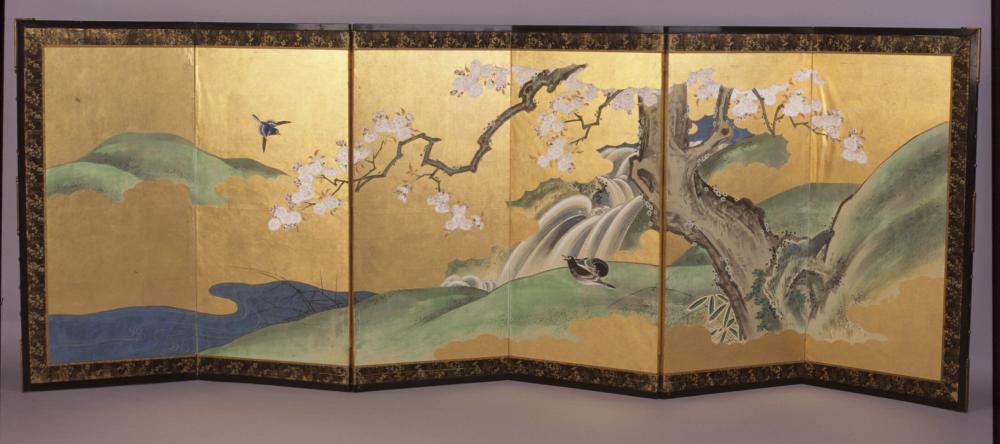
Sake bottle and cup made of cherry wood
This set was made of cherry wood from Arashiyama (near Kyoto), famous for its cherry blossoms. The sake bottle is actually a segment of a thick cherry branch. The bark was left in place, and the inside was hollowed out by turning and finally lacquered black. The cap, lacquered gold on the inside, doubles as a drinking bowl.
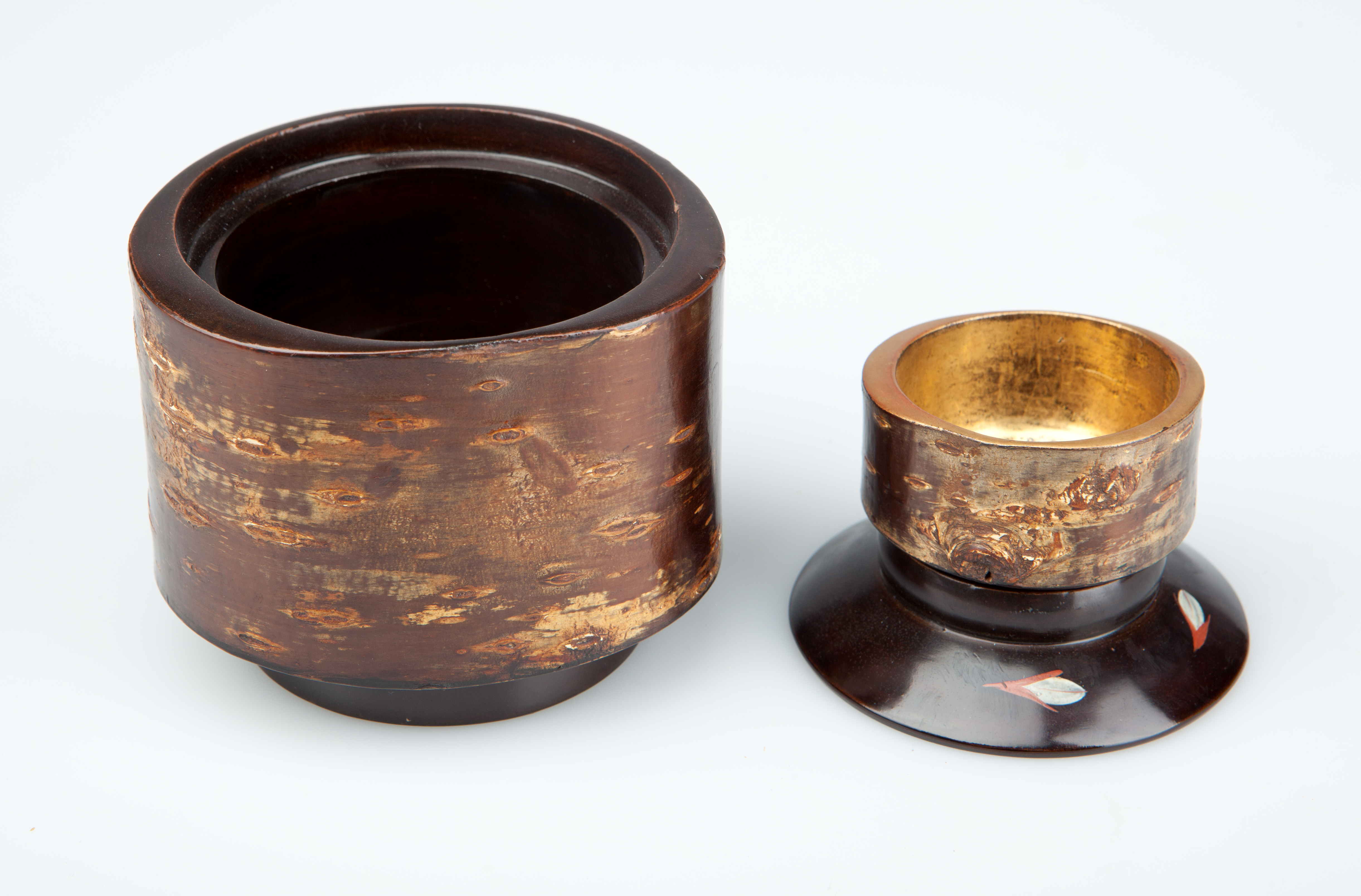
Luxury folding picnic set
Hanami is about admiring the cherry blossoms, but also about seeing and being seen. So, it is also an occasion for dressing up. And with a portable picnic set, one comes prepared. Unfolding this hexagonal set gives access to the beautiful lacquerware plates and veneered trays inside.
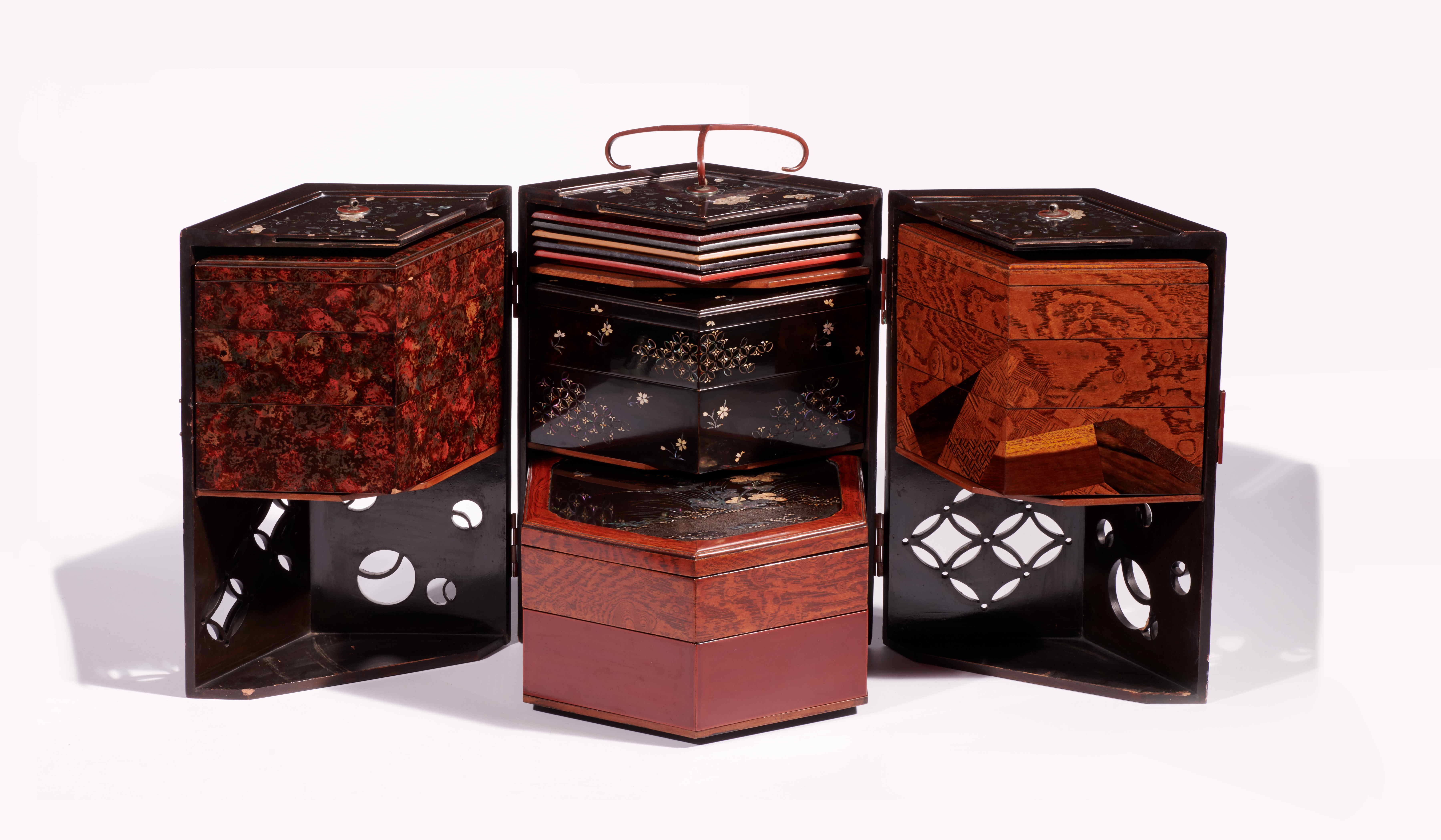
Blossoming cherry trees in the Yoshiwara brothel district
In the great city of Edo, present-day Tokyo, there was a walled district with rows of tea houses and brothels. The print shows the district in perspective. High-ranking prostitutes (often euphemistically called courtesans) parade the streets. They are recognisable by their luxurious, many-layered silk kimonos and the multitude of ornaments in their hair.
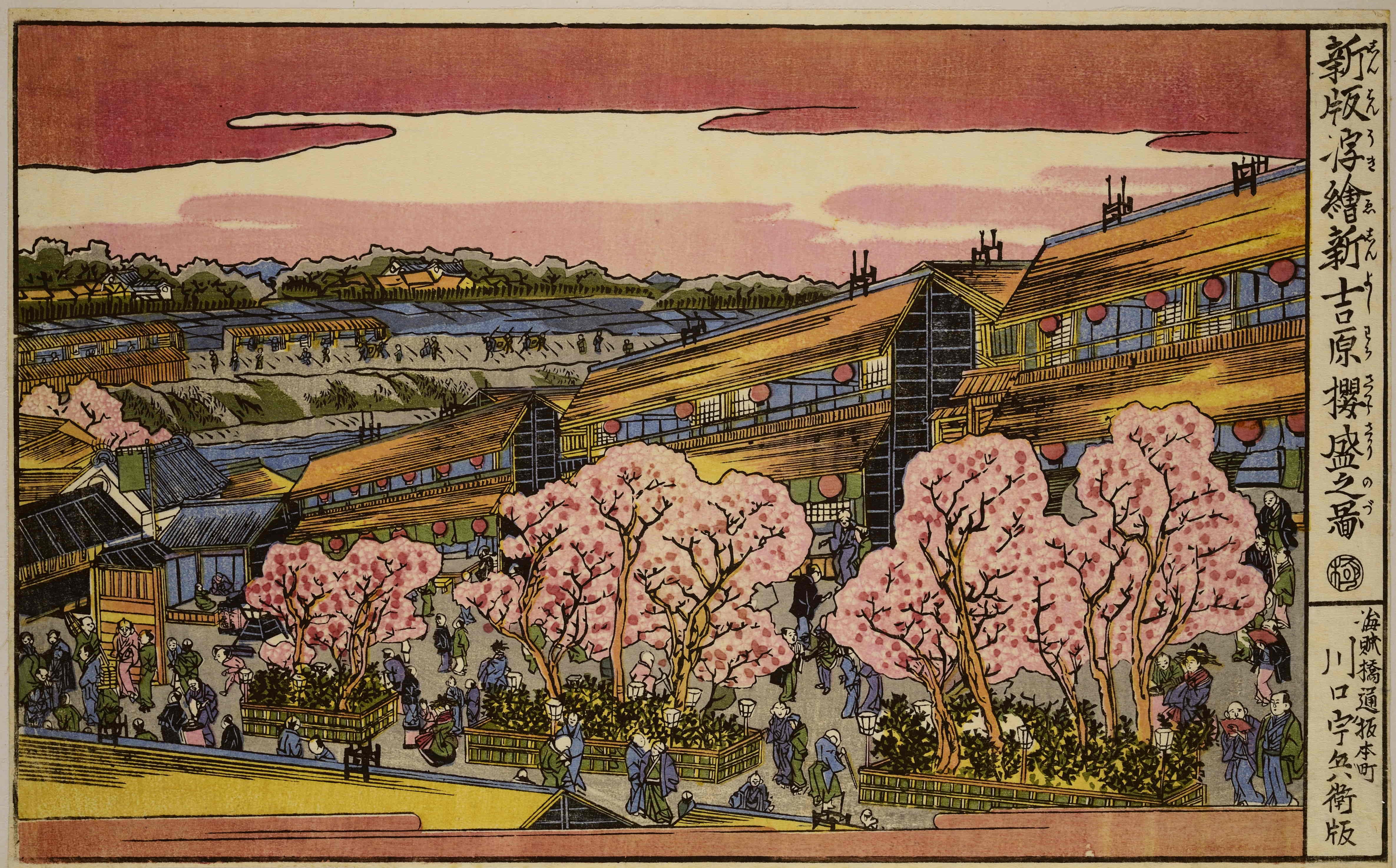
Three high-ranking prostitutes with their pupils
Young women who lived in and around the official brothel district were known as the ‘Flowers of Edo’ (present-day Tokyo). Their elegant appearance made them the fashion icons of their time. But their many-layered silk kimonos and hair ornaments cannot disguise the fact that theirs was a hard life. The designer of these woodblocks, Keisai Eisen, was a brothel owner himself for some time.
